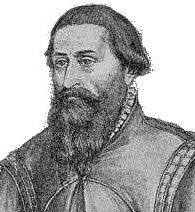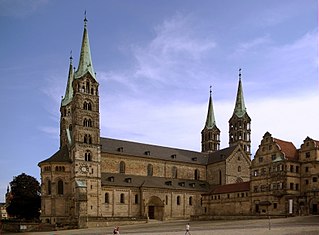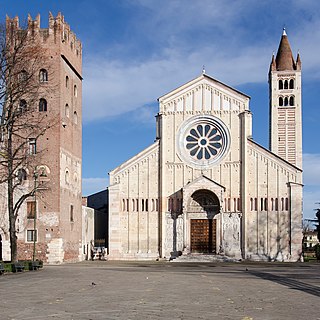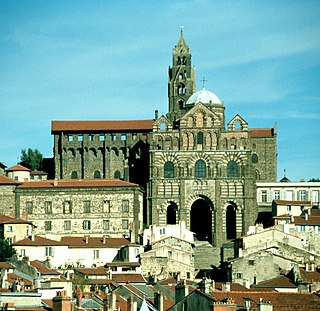
Veit Stoss was a leading German sculptor, mostly working with wood, whose career covered the transition between the late Gothic and the Northern Renaissance. His style emphasized pathos and emotion, helped by his virtuoso carving of billowing drapery; it has been called "late Gothic Baroque". He had a large workshop, and in addition to his own works there are a number by pupils. He is best known for the altarpiece in St. Mary's Basilica in Kraków, Poland.

Romanesque architecture is an architectural style of medieval Europe that was predominant in the 11th and 12th centuries. The style eventually developed into the Gothic style with the shape of the arches providing a simple distinction: the Romanesque is characterized by semicircular arches, while the Gothic is marked by the pointed arches. The Romanesque emerged nearly simultaneously in multiple countries ; its examples can be found across the continent, making it the first pan-European architectural style since Imperial Roman architecture. Similarly to Gothic, the name of the style was transferred onto the contemporary Romanesque art.

Cathedrals, collegiate churches, and monastic churches like those of abbeys and priories, often have certain complex structural forms that are found less often in parish churches. They also tend to display a higher level of contemporary architectural style and the work of accomplished craftsmen, and occupy a status both ecclesiastical and social that an ordinary parish church rarely has. Such churches are generally among the finest buildings locally and a source of regional pride. Many are among the world's most renowned works of architecture. These include St Peter's Basilica, Notre-Dame de Paris, Cologne Cathedral, Salisbury Cathedral, Antwerp Cathedral, Prague Cathedral, Lincoln Cathedral, the Basilica of Saint-Denis, Santa Maria Maggiore, the Basilica of San Vitale, St Mark's Basilica, Westminster Abbey, Saint Basil's Cathedral, Antoni Gaudí's incomplete Sagrada Família and the ancient cathedral of Hagia Sophia in Istanbul, now a mosque.

The narthex is an architectural element typical of early Christian and Byzantine basilicas and churches consisting of the entrance or vestibule, located at the west end of the nave, opposite the church's main altar. Traditionally the narthex was a part of the church building, but was not considered part of the church proper.

The Parish Basilica of Santa Maria del Popolo is a titular church and a minor basilica in Rome run by the Augustinian order. It stands on the north side of Piazza del Popolo, one of the most famous squares in the city. The church is hemmed in between the Pincian Hill and Porta del Popolo, one of the gates in the Aurelian Wall as well as the starting point of Via Flaminia, the most important route from the north. Its location made the basilica the first church for the majority of travellers entering the city. The church contains works by several famous artists, such as Raphael, Gian Lorenzo Bernini, Caravaggio, Alessandro Algardi, Pinturicchio, Andrea Bregno, Guillaume de Marcillat and Donato Bramante.

The Protestant Church of Peace is situated in the Marly Gardens on the Green Fence in the palace grounds of Sanssouci Park in Potsdam, Germany. The church was built according to the wishes and with the close involvement of the artistically gifted King Frederick William IV and designed by the court architect, Ludwig Persius. After Persius' death in 1845, the architect Friedrich August Stüler was charged with continuing his work. Building included work by Ferdinand von Arnim and Ludwig Ferdinand Hesse also. The church is located in the area covered by the UNESCO World Heritage Site Palaces and Parks of Potsdam and Berlin.

Bamberg Cathedral is a church in Bamberg, Germany, completed in the 13th century. The cathedral is under the administration of the Archdiocese of Bamberg and is the seat of its archbishop. Since 1993, the cathedral has been part of the UNESCO World Heritage Site "Town of Bamberg".

Johann-Georg Bendl, or Jan Jiří Bendl, was a Bohemian Baroque sculptor, who worked mainly in Prague.

Makaravank is a 10th-13th century church complex near the Achajur village of Tavush Province, Armenia, located on the slope of Paitatap Mountain. The complex of Makaravank ranks among Aghtamar, Bgheno-Noravank, Gandzasar with its originality, richness and variety of ornaments and occupies an important place in Armenian architecture.

The Basilica di San Zeno is a minor basilica of Verona, northern Italy constructed between 967 and 1398 AD. Its fame rests partly on its Romanesque architecture and partly upon the tradition that its crypt was the place of the marriage of Shakespeare's Romeo and Juliet.

The Christkindlesmarkt of Nuremberg is a Christmas market that is held annually in Nuremberg, Germany. It takes place during Advent in the Hauptmarkt, the central square in Nuremberg’s old town, and in adjoining squares and streets. With about two million visitors a year the Nürnberger Christkindlesmarkt is one of the largest Christmas markets in Germany and one of the most famous in the world. Every year the Christmas market begins on the Friday preceding the first Sunday in Advent and ends on Christmas Eve unless that day is a Sunday.

Le Puy Cathedral is a Catholic church located in Le Puy-en-Velay, in the French region of Auvergne. The cathedral is a national monument. It has been a centre of pilgrimage in its own right since before the time of Charlemagne, as well as being a stopover on the pilgrimage route to Santiago de Compostela. Since 1998 it has been part of a multi-location UNESCO World Heritage Site along France's Santiago pilgrimage routes. It is the seat of the Bishop of Le Puy.

Amalfi Cathedral is a medieval Roman Catholic cathedral in the Piazza del Duomo, Amalfi, Italy. It is dedicated to the Apostle Saint Andrew whose relics are kept here. Formerly the archiepiscopal seat of the Diocese of Amalfi, it has been since 1986 that of the Diocese of Amalfi-Cava de' Tirreni.

St. Mary's Church in Marienberg in the German state of Saxony is an Evangelical-Lutheran church in the southeast of the county of Erzgebirgskreis. It is the most recent of the three Ore Mountain Late Gothic hall churches.

Santa Monica Parish Church, commonly known as Minalin Church, is a Baroque Roman Catholic church, located in poblacion area of San Nicolas in Minalin, Pampanga, Philippines. The church, built during the Spanish era, was declared a National Cultural Treasure by the National Commission for Culture and the Arts and the National Museum of the Philippines on August 27, 2011, one of 37 churches in the country bestowed that honor.

The Church of the Holy Apostles Peter and Paul in Bydgoszcz is located in Bydgoszcz, Poland, on Wolności Square. Patron saints are Saint Peter and Saint Paul. The church, richly decorated with polychrome has been realized in 1957 by Władysław Drapiewski from Pelplin and Leon Drapniewski of Poznań; it has been registered on the Pomeranian Heritage List on 5 October 1971.

Immaculate Conception Parish Church, also known as La Purisima Concepcion de la Virgen Maria Parish Church and Baclayon Church, is a Roman Catholic church in the municipality of Baclayon, Bohol, Philippines within the jurisdiction of the Diocese of Tagbilaran. Baclayon was founded by the Jesuit priest Juan de Torres and Gabriel Sánchez in 1596, and became the oldest Christian settlement in Bohol. It was elevated as a parish in 1717 and the present coral stone church was completed in 1727. The Augustinian Recollects succeeded the Jesuits in 1768 and heavily renovated the church since then.

St. Wenceslas Church at Zderaz is a Gothic single-nave church in Prague – New Town. It is located at the crossroad of Resslova Street and Dittrichova Street.

The St. Catherine of Alexandria Church is a Roman Catholic church in the Tabán quarter of Budapest, Hungary. It is the parish church of the Tabán Parish which also comprises parts of Gellért Hill and Naphegy. The church is a listed monument that was built in Central European Baroque style between 1728 and 1777. It was reconstructed several times in the 19th–20th centuries.

The Donie Church is a Romanian Orthodox church located at 6 Maior Gheorghe Pastia Street in Focșani, Romania. It is dedicated to the Dormition of the Theotokos.





























